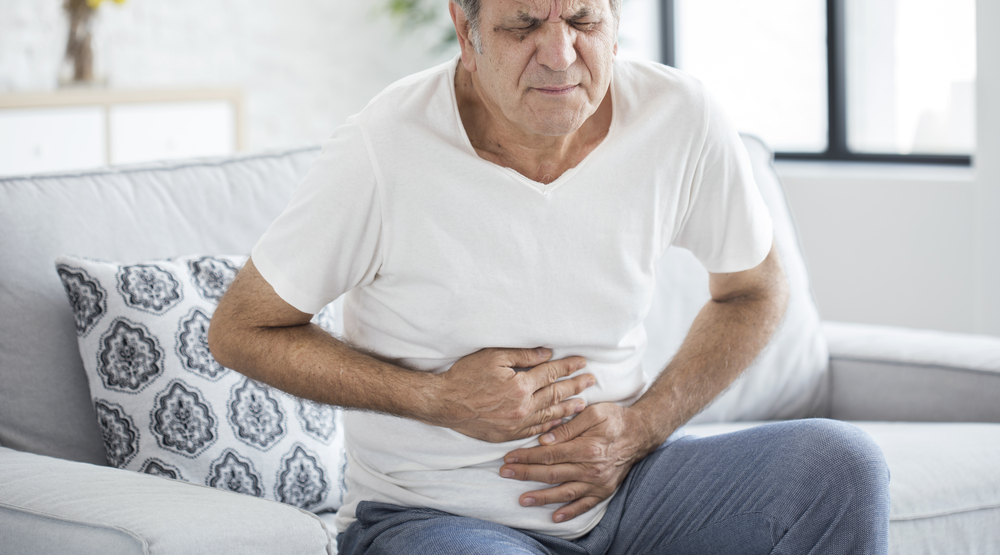If you’ve been dealing with unexplained abdominal pain, nausea, or vomiting, you may be wondering if gallstones are to blame. Gallstones are small, crystallized deposits that can form in your gallbladder. They don’t always cause obvious symptoms, but when they do, the pain can be intense. Read on for a breakdown of what gallstones are, how to tell if you have them, and what to do if you’re experiencing symptoms.
What are gallstones?
Gallstones, also called cholelithiasis, are small pieces of hardened material that form in your gallbladder. Your gallbladder is a pear-shaped organ that sits under your liver, next to your stomach. It’s responsible for storing the bile that your liver creates and squeezing the fluid through bile ducts to the opening of your small intestine as you eat. There, it mixes with your food and aids digestion by breaking down fats. Your gallbladder empties during digestion and refills as your liver produces more bile.
Sometimes, bile material will harden while in the gallbladder, leading to gallstones that can vary in size from a grain of sand to a golf ball. Usually, gallstones are small and harmless, but they can cause pain, inflammation, and nausea if they become lodged in a bile duct.
There are two types of gallstones:
- Cholesterol gallstones are the most common. They’re mostly made of hardened, undissolved cholesterol and are usually yellow in color.
- Pigment gallstones are more rare. They form when your bile has too much bilirubin, and they tend to be dark brown or black.
Gallstones can be diagnosed through blood tests or diagnostic imaging tests, such as abdominal ultrasounds or CT scans. If your gallstone passes on its own without pain, you probably won’t need treatment. However, if it’s causing pain or other symptoms, treatment may include gallbladder removal surgery or medications to help dissolve the gallstones.
What causes gallstones?
Bile is made up of cholesterol, bilirubin, and bile salt. While more research is needed to pinpoint what causes gallstones, the current theory is that they may form from these imbalances in your bile:
- Your bile has too much cholesterol. Your bile is responsible for dissolving the cholesterol that’s released from your liver. If there’s too much cholesterol for the bile to handle, it may start to crystallize and eventually form gallstones.
- Your bile has too much bilirubin. Sometimes, conditions like liver cirrhosis, certain blood disorders, and biliary tract infections may cause your liver to produce too much bilirubin. In your gallbladder, that excess bilirubin may lead to gallstone formation.
- Your gallbladder has trouble emptying. Your gallbladder is supposed to empty completely during digestion. If it doesn’t empty all the way (or doesn’t empty often enough), your bile can start to get very concentrated, which may lead to gallstones.
You may be more likely to develop gallstones if you are:
- Female
- 40 or older
- Native American or Hispanic of Mexican descent
- Overweight or obese
- Pregnant
Other factors that may increase your risk of gallstones include:
- Living a sedentary lifestyle
- Eating a diet high in fat or cholesterol
- Not eating enough fiber
- Fasting or rapid weight loss
- Family history of gallstones
- Having diabetes, liver disease, or certain blood disorders, including sickle cell anemia or leukemia
- Taking medication with estrogen, such as birth control pills or hormone replacement therapy
Can you prevent gallstones?
There’s no guaranteed way to prevent gallstones, but you may be able to decrease your chances of getting them by eating more fiber-rich foods and reducing your fat and cholesterol intake. Regular physical activity may also help, especially if you can reach and maintain a healthy weight. Lastly, avoid skipping meals or losing weight too quickly, as those actions can make your liver release more cholesterol in your bile and make it harder for your gallbladder to empty properly—both factors that increase your risk of gallstones.
What does gallstone pain feel like?
Gallstone pain can be sudden and intense, lasting anywhere from a few minutes to a few hours. This is called a gallbladder attack, and it usually happens when a gallstone gets stuck in a bile duct and causes a blockage. During a gallbladder attack, you may feel a sharp pain in the center or upper right part of your abdomen, possibly spreading up to your right shoulder or between your shoulder blades. Sometimes, gallstone pain is accompanied by nausea, vomiting, or excessive sweating.
Gallstone pain is constant during an attack, and it doesn’t go away after going to the bathroom, passing gas, or vomiting. These episodes may occur several weeks or months apart.
Talk to a doctor if your gallstones cause:
- Pain so intense that you can’t sit still or find a position to relieve it
- Pain that lasts for more than 8 hours
- Yellowing in your skin or the whites of your eyes (jaundice)
- High fever with chills
These are all signs of a severe gallstone complication and should be addressed immediately.
Can gallstones go away on their own?
Smaller gallstones may pass through your bile ducts without getting stuck. When this happens, they can travel through your intestines and ultimately be passed during a bowel movement. You may not ever see the gallstone in your stool, though, especially if it’s smaller.
For most people, gallstones aren’t dangerous. However, leaving your gallstones to pass on their own may lead to:
- Unpredictable and painful gallbladder attacks
- Inflammation or infection of the gallbladder, bile ducts, or pancreas
- Jaundice due to a blocked bile duct
2 out of 3 people who experience a painful gallbladder attack will go on to have one or more gallstone episodes during their lifetime.
When do you need surgery for gallstones?
When you have gallstones, your main options are surgery to remove your gallbladder or waiting to see if your gallbladder attacks get more frequent or painful. If your gallstone episodes don’t happen very often or you’re comfortable dealing with the pain, you may not need to have surgery. If you’ve had multiple painful gallbladder attacks, it may be time to talk with your healthcare provider about gallbladder removal surgery.
Gallbladder removal is the best way to prevent future painful gallstone episodes. It’s a common minor surgery with relatively low risks. (And yes, your body can digest food just fine without a gallbladder.)
What should you do if you think you need gallbladder surgery?
You deserve to walk through life without constantly worrying about when your next painful gallbladder attack will strike. To find out more about how the procedure works (and what it should cost), head over to our post on the cost of gallbladder surgery in the U.S.







